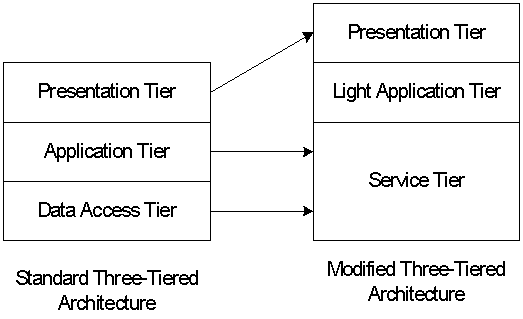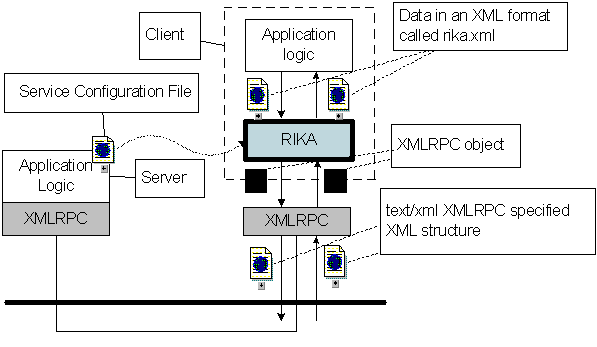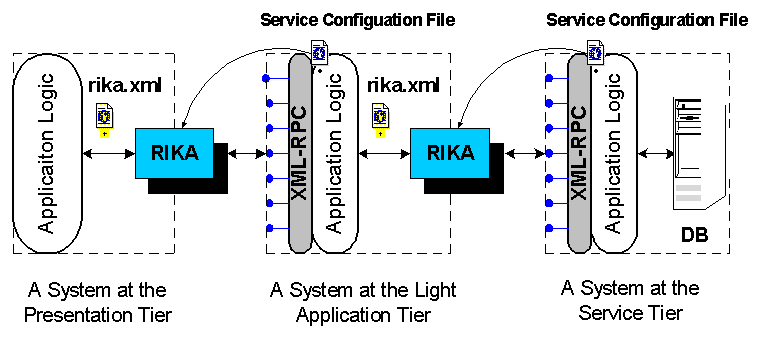An Alternate Three-Tiered Architecture for
Improving Interoperability for Software Components
Koju Iijima
Curtin University of Technology
GPO Box U1987
Perth 6845, Western Australia, Australia
+61 8 9266 7680
iijima@cs.curtin.edu.au
Jim Ivins
Curtin University of Technology
GPO Box U1987
Perth 6845, Western Australia, Australia
+61 8 9266 7680
jim@cs.curtin.edu.au
Allan Loh
Curtin University of Technology
GPO Box U1987
Perth 6845, Western Australia, Australia
+61 8 9266 7680
lohawk@cs.curtin.edu.au
Mike Robey
Curtin University of Technology
GPO Box U1987
Perth 6845, Western Australia, Australia
+61 8 9266 7680
mike@cs.curtin.edu.au
ABSTRACT
This paper describes an alternate three-tiered architecture,
coupled with an adaptive light reusable middleware component
(RIKA). The paper identifies several significant issues with the
standard three-tier model and proposes a solution via an alternate
three-tier model that makes use of the adaptive component. Finally,
the paper highlights the role of RIKA in mitigating these problems
within the alternate architecture.
Keywords
Heterogeneous distributed computing, multi-tiered architecture,
middleware, RIKA, XML-RPC, HTTP.
1. INTRODUCTION
In recent years there has been a dramatic growth in distributed
computing environments. Unfortunately, the size and variety of
heterogeneous computer systems make distributed computing difficult
and complex [1]. Thanks to improvements in computer technology, the
problem of size can be dealt with by separating systems into two
roles, namely client and server. Clients seek information from a
remote server, which offers services that produce information for
the clients. However, there is a wide variety of computing systems
with different architectures and different operating systems.
Interoperability is the key to mitigating the problem of
heterogeneity. To make systems interoperable, middleware is usually
required. Middleware is software that ewraps upf the architectural
details of a system and offers services to other systems on
heterogeneous platforms across a network [2].
Middleware can be used as a bridge between client and server.
The client / server architecture consists of two, three or more
tiers. In general, the logic of two-tiered and three-tiered
architectures is intrinsically different, but the three-tiered and
multi-tiered architectures are basically the same. Responsibility
for application specific tasks can be minimized in each tier, and
the roles can be separated into each tier. This helps to ensure low
coupling between tiers, with high cohesion within each tier. The
two-tiered architecture suffers from scalability and modularity
issues, hence a multi-tiered approach is best.
Unfortunately both the multi-tiered architecture and the use of
middleware have disadvantages. As the number of tiers increases,
the cohesion of each tier increases, but the coupling between tiers
does not decrease ? a change to one tier will affect neighboring
tiers. Having more than three tiers causes coupling and test
issues. Each tier has its own role that can be easily tested, but
testing the entire system becomes increasingly complex as the
number of tiers increase. Furthermore, existing middleware
protocols only achieve limited interoperability, while suffering
from reduced portability and greater design complexity.
This paper proposes a two-pronged strategy. An alternate
Three-Tiered architecture is proposed to tackle some of the client
/ sever architecture issues. A generic software component called
RIKA (Reusable Interoperable Komponent Architecture) is proposed to
solve middleware problems and improve the heterogeneity issues.
2. ALTERNATE THREE TIERED ARCHITECTURE
The standard three-tiered architecture consists of the
presentation, application and data access tiers. The main problems
encountered with the three-tiered model arise from the separation
of application and data access. The problem is many applications
require a high coupling between the bottom two tiers. For example
if a vendor-specific relational database product is used in the
data access tier, the interface to the product is usually called
ODBC (Object DataBase Connectivity) . In addition to the ODBC,
driver software is required to access a specific database.
Therefore, changing database architectures dramatically affects the
system at the application tier.
In the modified three-tiered architecture, the application tier
and the data access tier in the traditional three tier model are
combined into one tier, called the service tier. A new tier, known
as the light-application tier, is then inserted between the
presentation tier and the service tier. The role of the service
tier becomes focused more on communicating with the database, and
the role of the light-application tier focuses on handling
concurrent access and communications with the service tier. The
service tier handles concurrent accesses to the database instance
and manages changes to the database. This service tier prepares a
number of its own services that override methods or features of the
database such as select, insert, create, and so on. It is the
responsibility of the light-application tier to choose the
appropriate service interfaces. Naturally, this service tier must
include minimum-security issues regarding access to the client.
The light-application tier and the service tier are loosely
coupled. The light application tier only cares about changes to the
interfaces. Merging the application tier and the data access tier
into the service tier resolves the coupling issues. This ensures
that, no matter how the tiers are distributed, application and data
access will always reside together in the same location.

Figure 1. The structure of the standard three-tiered architecture
and the modified three-tiered architecture. The application and the
data access tiers are combined into the service tier. The light
application tier acts as an interface to the service tier.
3. RIKA
RIKA is a client-side software component designed to be a
flexible connector between the client and server. RIKA uses XML-RPC
as the middleware protocol. RIKA can adopt any interfaces at any
time, including the necessary data types and function (method)
declarations. In another words, RIKA can adopt any services that
the server offers to the component that deploys RIKA. RIKA
implements XML transfer functionality. It allows flexibly changing
the structure of XML that the client expects. This is called the
RIKA mapping. To perform its role, RIKA requires information about
the service. The information can be specified in a service
configuration file, the format of which is XML with a schema
defined by the RIKA component.

Figure 2. The infrastructure of the client/server architecture with
RIKA. The interface between RIKA and the application logic is an
XML formatted string, and between RIKA and XML-RPC is an XML-RPC
object.
Figure 3 shows a model that uses RIKA in the modified
three-tiered architecture.

Figure 3. RIKA in the modified three-tiered architecture.
Page limitations prevent a detailed discussion of how RIKA is
implemented and used. However, a detailed description will shortly
be published elsewhere [3].
4. CONCLUSION
The work presented here has examined some of the problems of
heterogeneous distributed computing, especially those of the
multi-tiered architecture and of middleware. A modified
three-tiered architecture with RIKA was introduced as the solution
for the problems identified.
Under the standard three-tiered model, the application tier and
the data access tier are tightly coupled because of the database
vendor dependency. The suggestion made here is to merge these tiers
together (thus resolving, at least partly, the coupling issues). A
new tier, known as the light-application tier then acts as a bridge
between the presentation and service tiers. This solution increases
the cohesion of each tier and prevents the overall system from
becoming overly complex. However, to solve coupling issues with
other tiers, there needs to be a mechanism that can adjust to
changes in the interfaces at each tier. The mechanism proposed here
is the RIKA component.
The advantages of using a system such as RIKA are improved
interoperability between different systems, and portability that
allows a system to connect and communicate with any other system.
The roles of the system are separated into that of the service
provider and the user of the service. This allows the service
provider to concentrate on maintaining it services, and delegate
the responsibility for adjusting to service changes to the user of
the service. RIKA offers an easy way to adapt to the changes. This
increases cohesion of the system and reduces the coupling between
systems.
5. REFERENCES
- McCann, J.A., Manning, K.J. Performance Management Tool for
Interoperable Environments. Proceedings of the 4th Annual
Conference of the British Computer Society Client/Server Group, CSG
'97. April 1997, p 60-70.
- Bray, M. Middleware. June, 1997. http://www.sei.cmu.edu/str/descriptions/middleware.html.
- Iijima, K. An Investigation into Methods for Improving the
Heterogeneous Distributed Computing Problem. Master of Science
Thesis. Curtin University of Technology, WA, Australia,
2003.


